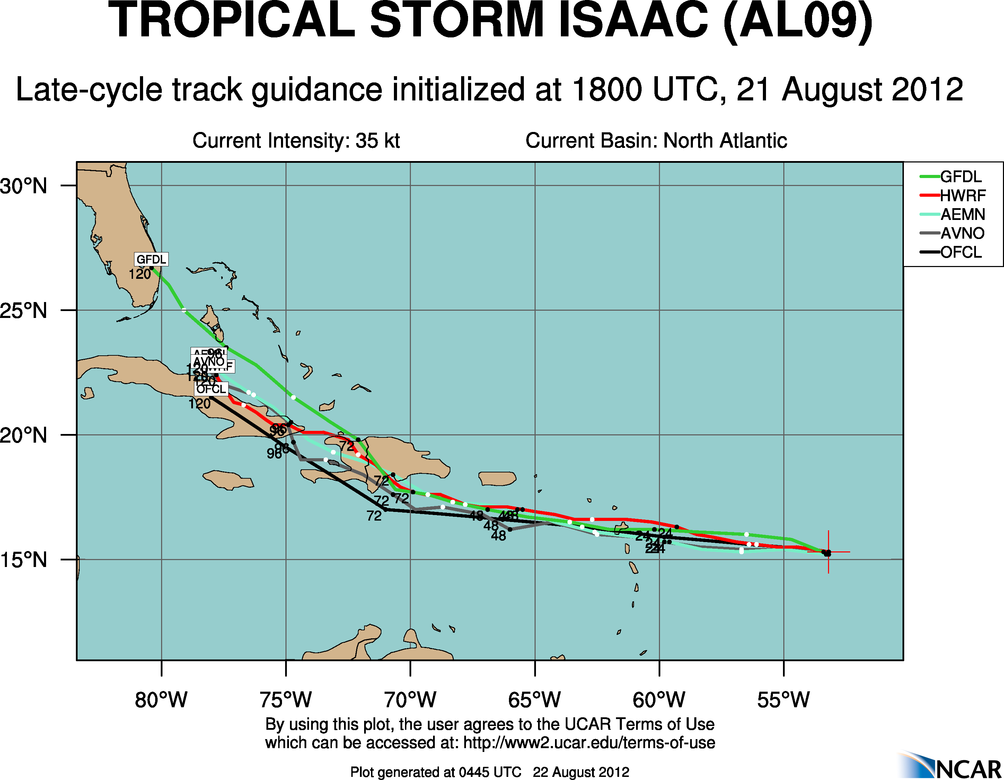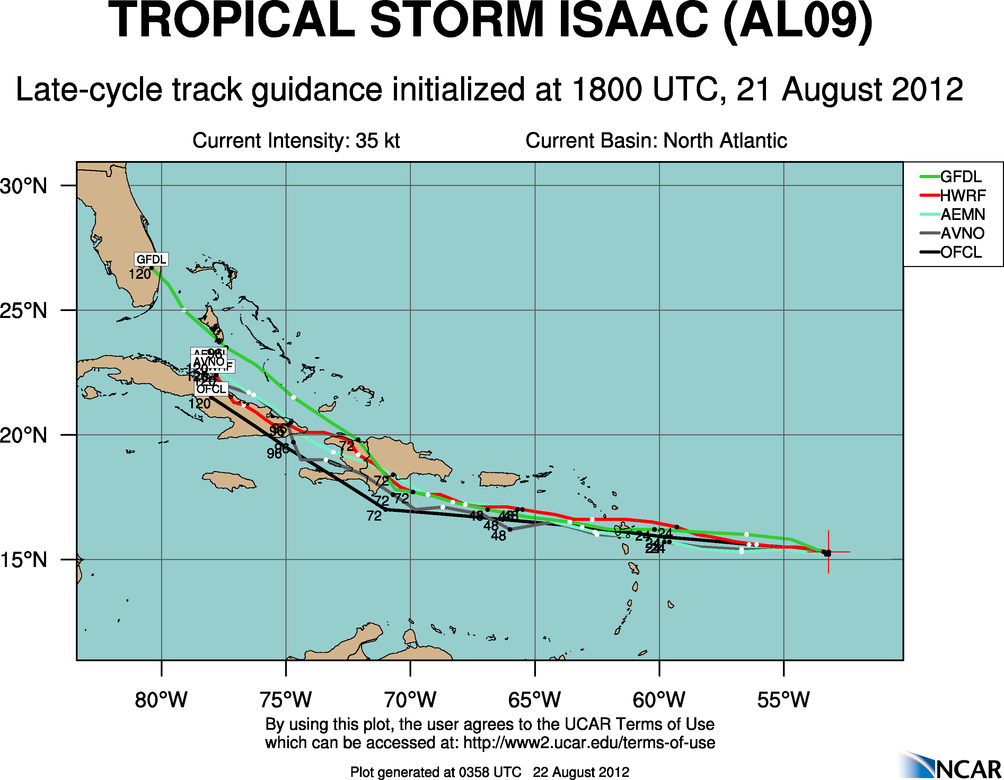Overview | History of Project Updates
History of Project Updates
NOTE: There have been many more updates to TCGP than are listed here. With time, some of the important changes may be documented here.
Reverse chronological list of all updates
DATE IMPORTANCE CATEGORY DESCRIPTION
- 13 Sep 2021 minor web/back-end See v2.5.2 bugfix notes for full details
- 20 Aug 2021 major all elements See v2.5 release notes for full details
- 10 Jul 2019 minor web/back-end Upgraded plotting scripts to use NHC's Potential Tropical Cyclone nomenclature
- 09 Oct 2017 minor back-end Upgraded back-end scripts to NCL 6.4.0 and other enhancements
- 21 Aug 2012 minor graphics Update to a higher resolution map database
- 20 Sep 2011 major web/back-end New server for TCGP
- 14 Aug 2011 major all elements Phase I released
13 Sep 2021 v2.5.2 Bugfix Upgrade
Several minor issues related to the v2.5 upgrade were found and fixed. The most significant issue was that product generation in the site was lagging behind the current cycle by 6 hours. Also, the link to the Houston radar was incorrect. The version number has been updated to v2.5.2.
The real-time compilation of Vortex Data Messages (VDMs) is not yet working in TCGP v2.5. Development to fix this is on hold until there is a storm within range of reconnaissance, but which is still far from land.
Unrelated to the v2.5 upgrade, a change made by the Joint Typhoon Warning Center (JTWC) broke TCGP's mirroring of the JTWC TCVITALS. This has been fixed.
20 Aug 2021 Major v2.5 Upgrade
TCGP has undergone its most significant upgrade since 2011. The new TCGP v2.5 has a drastically improved code infrastructure, is now able to be run in the cloud, adds important new data sources such as TCVITALS and CARQ data obtained directly from the Joint Typhoon Warning Center (JTWC), and adds new graphical products such as wind exceedance plots from a new probabilistic framework. To learn more about all of these changes, please visit the TCGP v2.5 release notes.
10 Jul 2019 Upgraded TCGP to handle Potential Tropical Cyclone nomenclature
TCGP has been updated to handle the nomenclature for Potential Tropical Cyclones in the basins handled by the National Hurricane Center (NHC). When a developing disturbance is expected to develop and bring impacts to land within typical watch and warning timeframes, but it does not yet meet the criteria of a tropical depression, NHC now issues advisories for such systems as 'Potential Tropical Cyclones'. These systems are given a stormnumber, but are still designated as a Disturbance or Low. TCGP will now provide the proper terminology for such systems.

Example of a plot using the Potential Tropical Cyclone nomenclature.
09 Oct 2017 Upgraded back-end scripts to NCL 6.4.0 and other enhancements
TCGP's numerous back-end data handling and plotting scripts have been upgraded to use the latest version of NCAR Command Language (NCL v6.4.0). This change will provide TCGP will the full capabilities of the latest version of NCL. During the upgrade process, a few data issues occurred, such as the CHIPS ensemble not making it into the a-decks. For a 24-hour period, the b-decks for the Western Pacific basin were incorrectly truncated to one line, and the a-decks for this basin did not have the CARQ lines inserted. All of these issues have now been fixed.
Additionally, two other enhancements were made to TCGP's back-end scripts. In the other global basins (e.g., Western Pacific, North Indian, Southern Hemisphere), the ATCF "cyclone type" field is typically not present. TCGP's routine that generates "nice" strings would normally put "CYCLONE TYPE UNKNOWN" in front of the storm name. This behavior has been changed so now nothing extra will be inserted before the storm name.
Also, this code has been updated to fix another issue. Because the ATCF field for stormname is truncated at 9 characters, when the stormname is a number (as is the case for tropical depressions), the truncated storm name (e.g., "TWENTY-TH") appeared in all of TCGP's links, page titles, and plots. Now, TCGP will use the full spelled-out number (e.g., "TWENTY-THREE").
21 Aug 2012 - Update to a higher resolution map database
The TCGP plotting system has been updated to use a newer, higher resolution map database. For those who like details, maps now use the "Earth..4" map database in NCAR Command Language (NCL). The previous map database ("Earth..1") did not include the island of Barbados, as well as some of the U.S. and British Virgin Islands, the Cayman Islands, and many other small islands. The new map database will also allow the state boundaries of Mexico, Brazil, Canada, and several other countries to be included. The outlines of U.S. counties will now be displayed whenever the range of the map domain is smaller than 30 degrees.

Example of a plot using the old map database. The coastline is coarse and several significant islands, such as Barbados and Grand Cayman, do not appear.

Example of a plot using the new map database. The coastline has much more detail and the map now displays the islands of Barbados, more of the British and U.S. Virgin Islands, the Cayman Islands, and many other smaller islands.
20 Sep 2011 - New server for TCGP
The TCGP moves to a new server today. We expect the transition to be seamless to the users if they are using the http://www.ral.ucar.edu/hurricanes/ entry point. If you were previously using http://verif.rap.ucar.edu/guidance/ then please update your links. If you are still having trouble, please let us know.
14 Aug 2011 - Phase I released
Phase I of the Tropical Cyclone Guidance Project (TCGP) was released today. In this initial release, the repository includes all available track and intensity forecasts in the National Hurricane Center's public ATCF a-decks as well as the developmental tracker results from the UK Met Office global model. This release also features four types of real-time guidance plots for the North Atlantic, Northeast Pacific, and Central Pacific basins.
These plot types are:
- early cycle track guidance,
- late cycle track guidance,
- GFS ensemble track guidance, and
- early cycle intensity guidance.
Phase I also implements a global overview map of current tropical cyclone activity with links to individual storm pages. Various text data files are also linked from each storm's individual storm pages. To find out more about our plans for future phases of this site's development, click here.